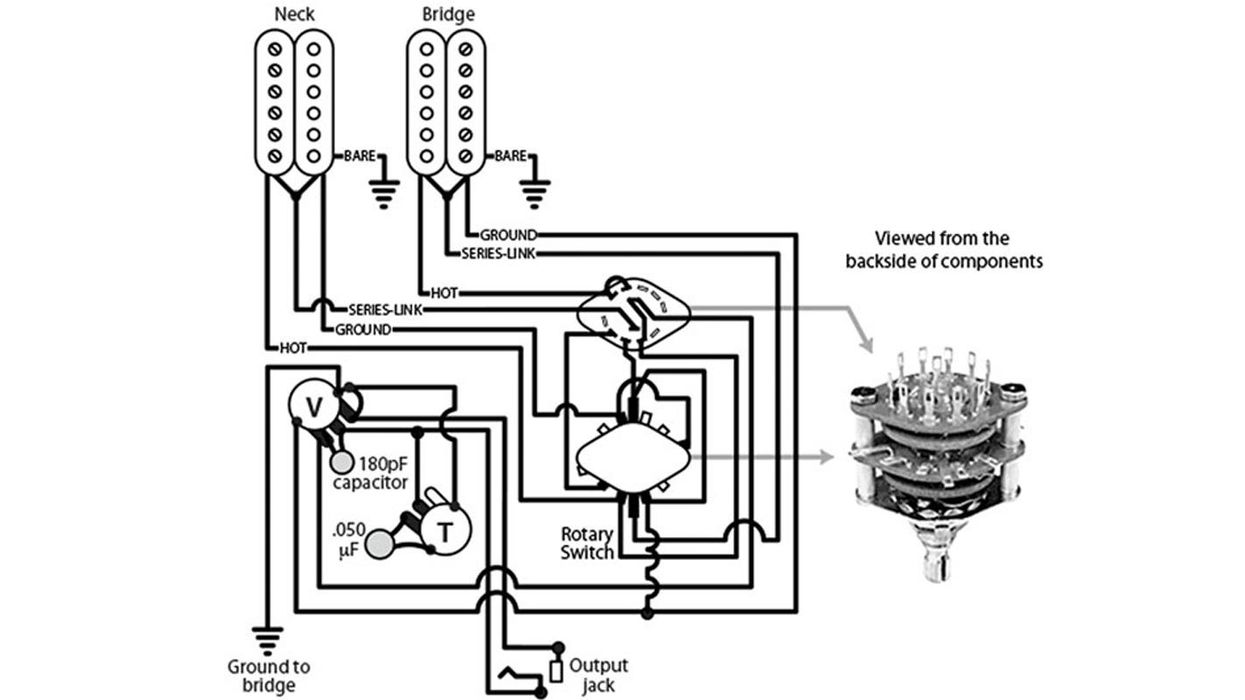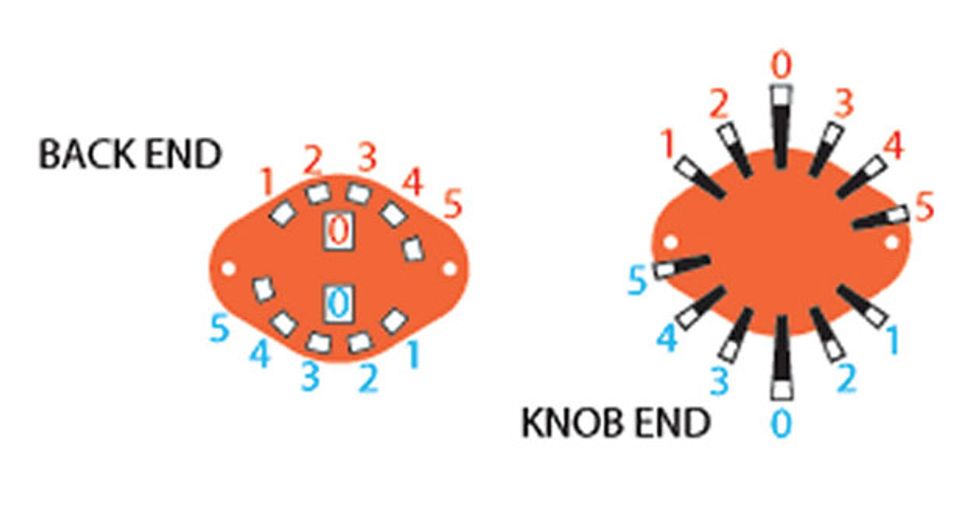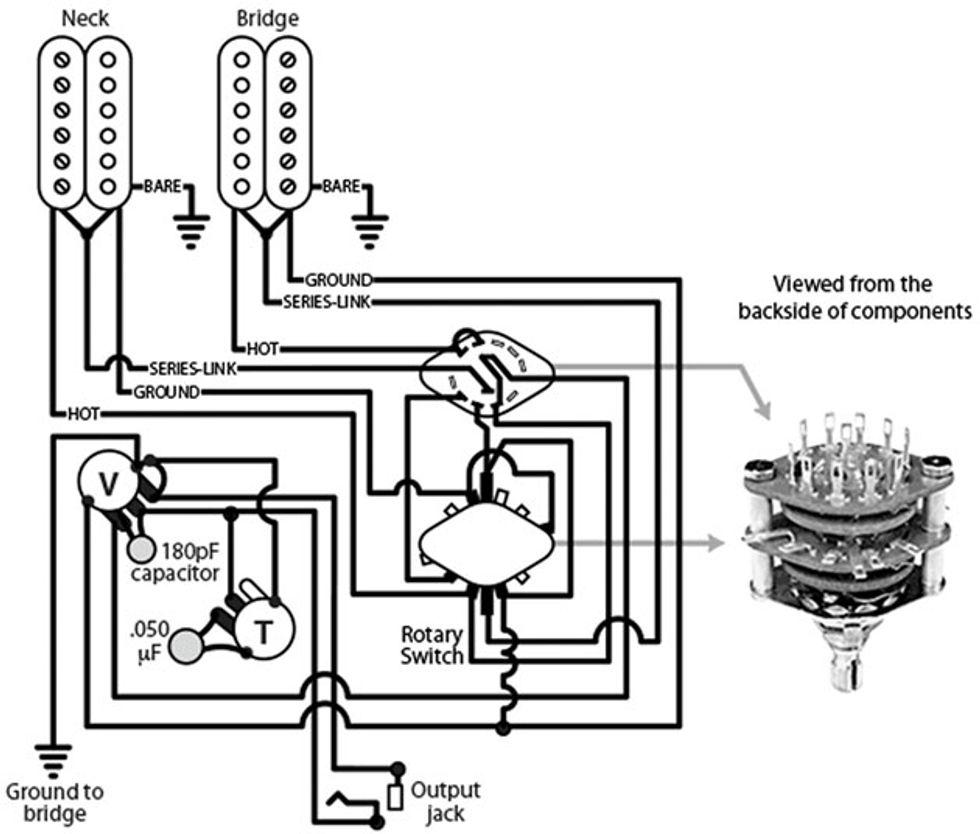This month let's explore the glory of installing a 5-way rotary switch in a dual-humbucker guitar. PRS popularized 5-way rotary switching on such models as the Custom 22 and Custom 24, and it provides very useable pickup combinations you can't get with a standard 5-way blade switch. (We'll look at adapting the system to other pickup configurations in a future column.)
The guitar. To use this wiring, the pickups in your HH-loaded guitar must have 4-conductor wiring—it won't work with vintage-style 2-conductor pickups. Also, to function without phase and noise problems, the outside coils of the humbuckers should have opposite polarity. There are easy ways to verify pickup polarity: You can use a polarity tester (such as the inexpensive Magnet Polarity Tester from Schatten Design), or simply place one pickup over the other. If they attract each other, they have opposite polarities. If not, they have the same polarity. (Even then, you don't necessarily need to use a different pickup. There's a way to flip the pickup magnet 180 degrees, but this should be done by an experienced guitar tech. The wires inside are very tiny, so please leave this work to a pro.)
The switch. You need a 5-position rotary switch with 4 poles (aka 4P5T) and soldering lugs. Make sure it fits your guitar—those switches are rather long, and you need a minimum depth of 35 mm. Several companies make such switches. I often use part #3512 (Photo 1) from stewmac.com.
The switching matrix. Here's the PRS switching matrix we're aiming for:
- Position 1 = neck humbucker
- Position 2 = outer coils in parallel
- Position 3 = outer coils in series
- Position 4 = inner coils in parallel
- Position 5 = bridge humbucker
This clever and versatile system gives you humbucker tones in positions 1, 3, and 5, as well as single-coil-like tones in positions 2 and 4 (minus the hum and noise of real single-coils). This is indeed the best of both worlds, so a big shout-out to Paul Reed Smith for creating such a cool wiring!
Weighing the pros and cons. The system looks clean and cool, and it provides pickup combinations you can't get from a standard 5-way switch. The downside: You lose the sound of both humbuckers engaged. The switch's dimensions are problematic in some guitars. With a rotary switch, it can be difficult to discern your pickup-selector setting at a glance. And you can get the same results with a blade-style Oak Grigsby Super Switch.
The wiring. These rotary switches have two levels, each with a set of solder lugs (Image 2), so it's always important to know where you are. The lower stage (back end) is the one with straight lugs, and the upper stage (knob end) is the one with the lugs extending outward from the sides of the switch.
Pickup wire colors vary from manufacturer to manufacturer. If you're not sure what's what, consult Seymour Duncan's helpful pickup color code sheet.
The small 180 pF cap in Image 3 is the kind of treble bleed network PRS uses to maintain highs when rolling back the volume control. (I recommend a silver mica cap in this position.) The tone cap PRS prefers is a 0.022 µF film/foil type. The wiring diagram shows a 0.05 µF cap, but go with a 0.022 µF if you want to be as PRS-ish as possible. That's it!
Next month we'll have something really special: mods for classical guitar players looking to speed up the grueling process of changing nylon strings. This will be the first time Mod Garage ventures beyond electric guitars, and I'm really looking forward to it. Until then ... keep on modding!
Images courtesy of Stewart MacDonald













































